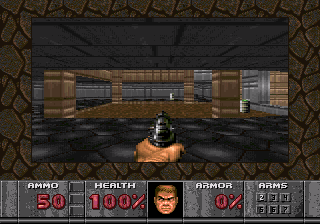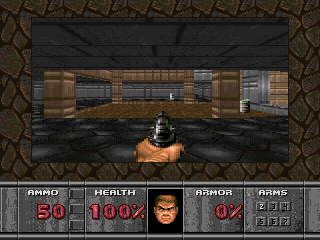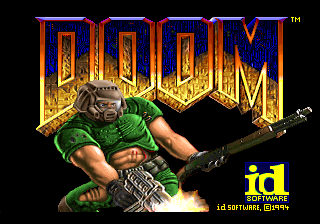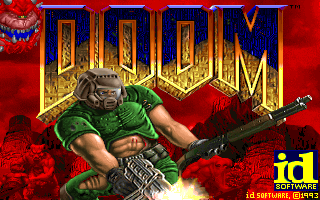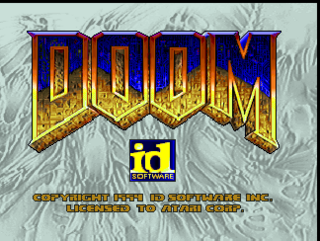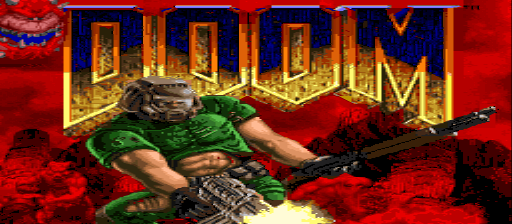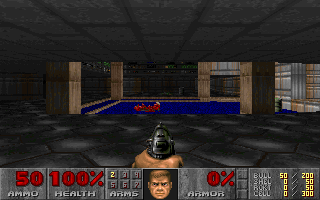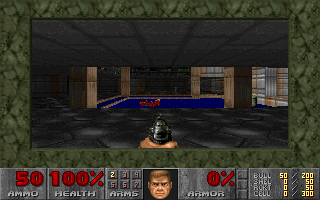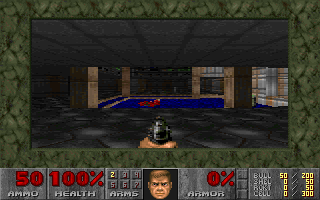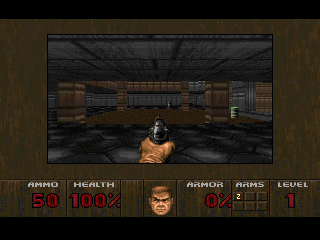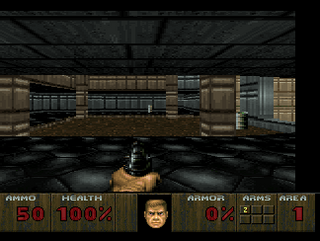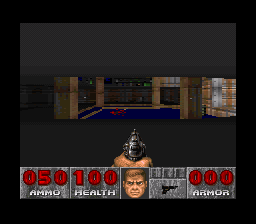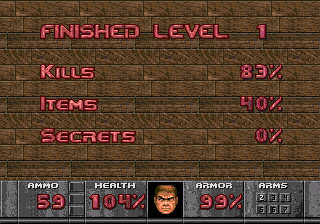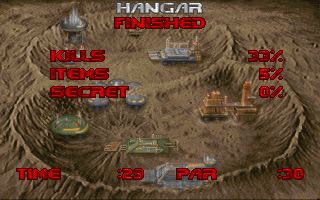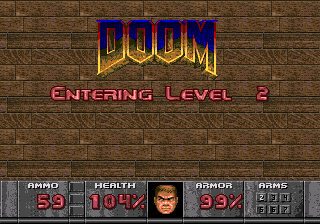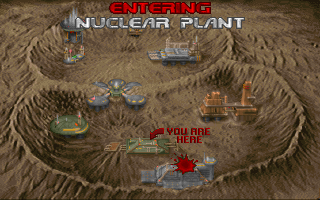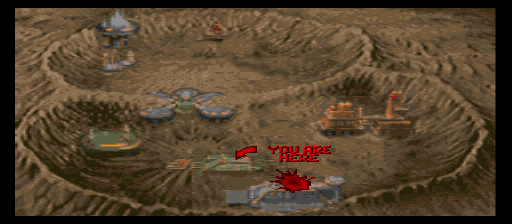Difference between revisions of "Doom (32X)/Comparisons"
From Sega Retro
| Line 54: | Line 54: | ||
| game5=Super NES | | game5=Super NES | ||
| desc=However, while 32X's shortcomings are obvious, they are not unique among other consoles of the era. The 3DO, which on paper should greatly surpass the 32X's specifications, runs with a thicker border (albeit without pixel width doubling), and alongside the Jaguar, share the same frame rate issues. The Super NES which is not based on Jaguar code, chose a different approach, sacrificing floor and ceiling textures. | | desc=However, while 32X's shortcomings are obvious, they are not unique among other consoles of the era. The 3DO, which on paper should greatly surpass the 32X's specifications, runs with a thicker border (albeit without pixel width doubling), and alongside the Jaguar, share the same frame rate issues. The Super NES which is not based on Jaguar code, chose a different approach, sacrificing floor and ceiling textures. | ||
| + | }} | ||
| + | {{Comparison | ||
| + | | image1=Doom 32X Level1 End.png | ||
| + | | image2=Doom IBMPC E1M1 End.png | ||
| + | | image3=Notavailable.svg | ||
| + | | image4=Notavailable.svg | ||
| + | | image5=Doom SNES E1M1 End.png | ||
| + | | game1=32X | ||
| + | | game2=IBM PC | ||
| + | | game3=3DO | ||
| + | | game4=Atari Jaguar | ||
| + | | game5=Super NES | ||
| + | | desc=Most versions of the game present less information when completing a level. | ||
| + | }} | ||
| + | {{Comparison | ||
| + | | image1=Doom 32X Level2 Transition.png | ||
| + | | image2=Doom IBMPC E1M2 Transition.png | ||
| + | | image3=Notavailable.svg | ||
| + | | image4=Notavailable.svg | ||
| + | | image5=Doom SNES E1M2 Transition.png | ||
| + | | game1=32X | ||
| + | | game2=IBM PC | ||
| + | | game3=3DO | ||
| + | | game4=Atari Jaguar | ||
| + | | game5=Super NES | ||
| + | | desc=And likewise, most sacrifice the map. Although given that stages are not played in the correct order in some ports, this would make sense. The game's successor, ''Doom II'' also ditched these maps screens, so perhaps they had fallen out of fashion at id Software. | ||
}} | }} | ||
Revision as of 16:59, 6 December 2019
- Back to: Doom (32X).
Localisation comparisons
| NTSC-J/NTSC-U |
|---|
| PAL |
|---|
The PAL version technically runs in the full 320x240 resolution (versus 320x224 for NTSC), but the extra 16 rows of pixels are only used to extend the height of the HUD, making it less accurate compared to the original IBM PC version in the process. The real gameplay window is 256x144 in both versions (or 128x144, as there is a pseudo-doubling of pixels on the horizontal axis).
Version comparisons
| 32X |
|---|
| IBM PC |
|---|
| 3DO |
|---|
| Atari Jaguar |
|---|
| Super NES |
|---|
Doom on the 32X does not hold up well when placed side-by-side with the original IBM PC version. The title screen lacks a background (and a Cacodemon) and has been blindly ported over from the PC version, with no attempt to adjust for the different aspect ratio (IBM PC Doom runs at 320x200 while the 32X attempts 320x224, so all ported graphics appear "fatter" than they should). As a result of this, there is a 12 pixel horizontal border at the top and bottom of the image, meaning the space marine's legs are abruptly chopped off.
The 32X version arguably fares well against the 3DO and Jaguar versions, however, which opt not to have the space marine in the title screen at all. Only the Super NES has a complete version of the original title screen, albeit in fewer colours.
| 32X |
|---|
| IBM PC |
|---|
| IBM PC (border) |
|---|
| IBM PC (border; "low" graphics detail) |
|---|
The 32X version does not run in full-screen. You can simulate a similar look in the IBM PC version by adding borders (pressing "-" twice) and setting the graphics detail setting to "low" (which doubles the width of in-game pixels).
While perhaps a crude way to play today, Doom on the PC officially supports Intel 386 processors with as little as 4MB of RAM. For many users in 1993/1994, achieving stable performance (maxing out at 35FPS) required that these memory-saving measures were used, so at a quick glance, the 32X's visuals would not have been out of the ordinary for the time.
To get the game running on the Atari Jaguar (and by extension, this 32X port), a further round of cost-cutting was introduced, with simplified geometry, fewer textures and less static scenery (such as the dead space marine in the opening of E1M1, assuming this is not console censorship). It creates an "emptier" and a less colourful Doom experience, with more browns and greys rather than, for example, the blue carpet seen above.
On top of the Jaguar changes, the 32X has to make do with a lower colour count for its HUD (owing to the fact this section is being drawn by Mega Drive hardware, not 32X) and a lower average frame rate.
| 32X |
|---|
| IBM PC |
|---|
| 3DO |
|---|
| Atari Jaguar |
|---|
| Super NES |
|---|
However, while 32X's shortcomings are obvious, they are not unique among other consoles of the era. The 3DO, which on paper should greatly surpass the 32X's specifications, runs with a thicker border (albeit without pixel width doubling), and alongside the Jaguar, share the same frame rate issues. The Super NES which is not based on Jaguar code, chose a different approach, sacrificing floor and ceiling textures.
| 32X |
|---|
| IBM PC |
|---|
| 3DO |
|---|
| Atari Jaguar |
|---|
| Super NES |
|---|
Most versions of the game present less information when completing a level.
| 32X |
|---|
| IBM PC |
|---|
| 3DO |
|---|
| Atari Jaguar |
|---|
| Super NES |
|---|
And likewise, most sacrifice the map. Although given that stages are not played in the correct order in some ports, this would make sense. The game's successor, Doom II also ditched these maps screens, so perhaps they had fallen out of fashion at id Software.
References
| Doom (32X) | |
|---|---|
|
Main page | Comparisons | Maps | Hidden content | Development | Magazine articles | Video coverage | Reception | Region coding | Technical information | |
